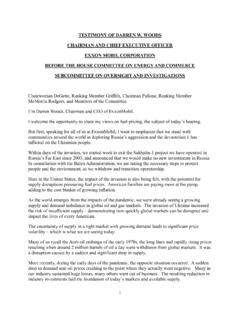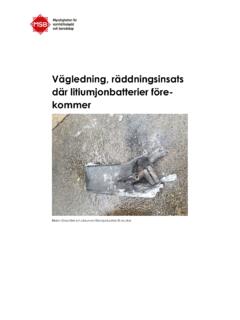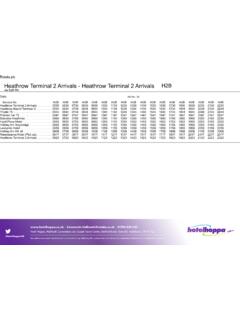Transcription of Four Point Bending Test [formules] - UMinho
1 THEORY OF THE. FOUR Point DYNAMIC Bending TEST. PART I: GENERAL THEORY. Author: Pronk P-DWW-96-008. ISBN-90-3693-712-4. Edition: December 2006. Disclaimer The Road and Hydraulic Engineering Division (DWW) of the Rijkswaterstaat has collected the data in this publication using the latest scientific and technical knowledge. Errors may nevertheless occur in this publication. The Kingdom of the Netherlands takes no responsibility for any losses incurred as a result of using these data. PREFACE. This document contains the background, theory and interpretation procedures of the FOUR Point DYNAMIC Bending TEST. The 4 Point dynamic Bending test is used for the investigation of pavement material properties like stiffness modulus and fatigue characteristics.
2 The purpose of this document is to give an overview of the equations which govern the interpretation of the measurements. While the equations for static Bending are well known, this is not the case in dynamic Bending . In principle the equations1 are derived for the 4 Point dynamic test but the theory can easily be extended to the 3 Point dynamic test, which has the same geometrics. The following items are discussed: Chapter 1: General theory for the Bending of a rectangular beam;. The derivations of the differential equations are given for a slender beam. It is shown that in case of an asphalt beam only a few terms in the differential equations are important leading to the differential equations for pure Bending . Chapter 2: The static Bending case.
3 In this chapter the solution of the basic 4th order differential equation is derived. It is shown that this solution is equal to the more familiar two (three) equivalent 2nd order differential equations, which are frequently used in handbooks. Also the influences of the placing of the 4 clamps along the beam are briefly discussed. In the static case it is not relevant that a difference exists between the actual beam length Ltot and the distance L between the two outer clamps. Chapter 3: The dynamic Bending of an elastic beam;. The exact solution is derived in the case of pure Bending . The actual beam length Ltot is equal to the distance L between the two outer clamps. Only the mass of the beam is taken into account. The solution consists out of an infinite series of cosine terms.
4 It is shown that a 1st order approximation (only the first term of the series) covers more than 95 % of the exact solution. Using the coefficient of the solution for static Bending , a modified approximation will lead to even better results for common asphalt properties. This approximation is mathematically equivalent to the solution for a mass-spring system. Chapter 4: The dynamic Bending of a viscous-elastic material;. 1 For clarity reasons in this 2006 edition the times symbol x is replaced in the equations/formulas by a dot.. In the text the product sign x is still used if necessarily The exact solution is derived in the case of pure Bending . The actual beam length Ltot is equal to the distance L between the two outer clamps. Only the mass of the beam is taken into account.
5 The solution consists out of an infinite series of cosine terms. Again a 1st order approximation covers more than 95 % of the exact solution. Because the form of the approximation is equal to the solution for a mass - (viscous- elastic) spring system, an equivalent mass can be given representing the influence of the actual weight of the asphalt beam. Of course this equivalent mass will depend on the place along the beam where the response (deflection) will be measured. Also the solutions for the homogenous differential equation are given, which are needed in the case that the actual beam length Ltot is longer than the distance L between the two outer clamps. Chapter 5: The influence of (extra) moving masses at the two inner clamps;. In this chapter it is shown how to incorporate these forces in the theory for a viscous-elastic beam, provided that the actual beam length Ltot equals the distance L between the outer clamps.
6 A 1st order approximation is given, which again equals the solution for a mass - (viscous-elastic) spring system. The equivalent mass is given in case of the DWW. specifications and if the response is measured in the centre of the beam. Chapter 6: The influence of the overhanging beam ends (Ltot > L) on the deflection for an elastic beam;. For the case that no extra moving masses are present at the two inner clamps, the exact solutions are derived in this chapter for an elastic beam. Chapter 7: The influence of the overhanging beam ends (Ltot > L) on the deflection for a viscous-elastic beam;. For the case that no extra moving masses are present at the two inner clamps, the exact solutions are derived in this chapter for a viscous-elastic beam.
7 It is shown that in case of the DWW specifications (_=450 mm; L=400 mm) the introduced error is very small. An approximation procedure is given if extra moving masses are present. Chapter 8: Advised interpretation formulas for the back calculation of Stiffness modulus from deflection measurements on asphalt beams; in this chapter an overview is given of the advised equations for the back calculation procedure of measurem- ents carried out in a 4 Point dynamic Bending test with the DWW and ASTM specifications. 2. Contents Chapter 1: Bending Theory for a Rectangular Beam General Theory pp. 7. Four and three Point Bending pp. 9. Conclusions pp. 13. Chapter 2: Static Bending Solution using a series development in orthogonal sine's pp. 14. Summation of the infinite series pp.
8 16. The common second order differential equation in static Bending pp. 18. Solution of the second order differential equation pp. 20. General pp. 20. Maximum strain and stress in the beam pp. 22. Mean deflection pp. 22. Interpretation procedure for determining the Young's modulus E, maximum strain and stress from static Bending tests pp. 23. ASTM Specifications pp. 24. DWW Specifications pp. 24. First order approximation of the solution expressed in an infinite series of sine's pp. 25. Chapter 3: Dynamic Bending of an Elastic Beam (Accounting only for the mass of the beam). General pp. 32. Dynamic solution in case _ = L pp. 34. Centre Deflection pp. 35. ASTM Specifications pp. 36. First order approximation pp. 37. 3. Calculation of occurring strains in the beam pp.
9 41. Chapter 4: Dynamic Bending of a Viscous-Elastic Beam (Ltot = L). Homogenous differential equation (Q[x,t]=0) pp. 45. Force controlled Bending pp. 47. Prescribed displacement profile without phase lag differences pp. 51. First order approximation for the "Force controlled Bending case" and back calculation of the stiffness modulus from measurements pp. 53. Chapter 5: Concentrated masses at the two inner clamps Development of the mass forces into a force distribution pp. 59. Simplified procedure for the deflection calculation pp. 61. Back calculation procedure pp. 63. Chapter 6: Dynamic Bending of an Elastic Beam with a length Ltot longer than the length L between the two outer clamps pp. 65. Chapter 7: Dynamic Bending of a Viscous-Elastic Beam with a length Ltot longer than the length L between the two outer clamps pp.
10 68. Chapter 8: An Overview of the Advised Equations for the Backcalculation Procedure General Formulas pp. 75. ASTM Specifications pp. 77. DWW Specifications pp. 78. 4. SYMBOLS. a = Distance between inner clamps [m]. b = Width of the beam [m]. fn = Tuning coefficient [-]. go,gn = Tuning coefficients (chapter 5) [-]. h = Height of the beam [m]. i = Imaginary unit: + (-1) [-]. n = Integer number sn = Tuning coefficient [-]. t = Time [s]. x = Coordinate [m]. y = Coordinate [m]. A = Coordinate of the first inner clamp [m]. An,An* = Constants [m]. B = Coordinate of the second inner clamp [m]. C1,2,3,4,5 = Symbols for constants [-]. Cn = Constants [m]. D1,2,3,4,5 = Symbols for constants [-]. Dn = Constants [m]. E1,2 = Symbols for constants [-]. E = Young's modulus [Pa].




